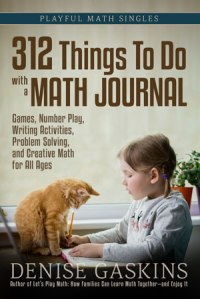Writing to Learn Math: When students create their own math, they forge a personal connection to mathematical concepts and relationships. And it’s fun!
Do you want your children to develop the ability to reason creatively and figure out things on their own?
Help kids practice slowing down and taking the time to fully comprehend a math topic or problem-solving situation with these classic tools of learning: Notice. Wonder. Create.
Notice: Look carefully at the details of the numbers, shapes, or patterns you see. What are their attributes? How do they relate to each other? Also notice the details of your own mathematical thinking. How do you respond to a tough problem? Which responses are most helpful? Where did you get confused, or what makes you feel discouraged?
Wonder: Ask the journalist’s questions: who, what, where, when, why, and how? Who might need to know about this topic? Where might we see it in the real world? When would things happen this way? What other way might they happen? Why? What if we changed the situation? How might we change it? What would happen then? How might we figure it out?
Create: Create a description, summary, or explanation of what you learned. Make your own related math puzzle, problem, art, poetry, story, game, etc. Or create something totally unrelated, whatever idea may have sparked in your mind.
Math journaling may seem to focus on this third tool, creation. But even with artistic design prompts, we need the first two tools because they lay a solid groundwork to support the child’s imagination.
How To Use a Create-Your-Own-Math Prompt
When students create their own math, they forge a personal connection to mathematical concepts and relationships. And it’s fun!
Children might make up a math game, write a story or poem, draw a comic, or pose a problem. Create math art, think up a challenging question, or write a puzzle. Since earlier chapters focused on writing and math art, most of these prompts involve creating puzzles or problems.
The “Story Problem Challenge” is one of my favorite math club activities. My students invent their own word problems in any style they like. They don’t have to know how to solve the problems they create. We read the stories aloud, and everyone works together to find the solutions.
For puzzles where the child already knows the answers (for example, “Two Truths and a Lie”), let them trade with a friend. Can they each solve the other’s puzzle? Can they stump each other? Or save the child’s work and let them come back to it another day, after they’ve forgotten the answers.
And when students create something they’re proud of, let them share it with the world. Visit the Student Math Makers Gallery at tabletopacademy.net/math-makers to learn how your students can submit their own math creations.
Journaling Prompt 103: Lines on a Grid
Use dotty graph paper. With a ruler, draw a slanted straight line between two dots on your page.
Can you draw another line parallel to the first? How do you know it’s parallel?
Can you draw a line that’s perpendicular? How can you be sure?
Make a design with parallel and perpendicular lines. Color as desired, or fill each section with a pattern.
* * *
 This is an excerpt from 312 Things To Do with a Math Journal. Discover more of my books, printable activities, and cool mathy merch at Denise Gaskins’ Playful Math Store.
This is an excerpt from 312 Things To Do with a Math Journal. Discover more of my books, printable activities, and cool mathy merch at Denise Gaskins’ Playful Math Store.
Special Offer: Would you like to access a growing archive of Thinking Thursday prompts and other activity ideas as convenient printable pdf downloads, ready to print and play with your kids? Join me on Patreon for mathy inspiration, tips, printable activities, and more.
“Thinking Thursday: Lines on a Grid” copyright © 2024 by Denise Gaskins. Image at the top of the post copyright © 4masik / Depositphotos.
